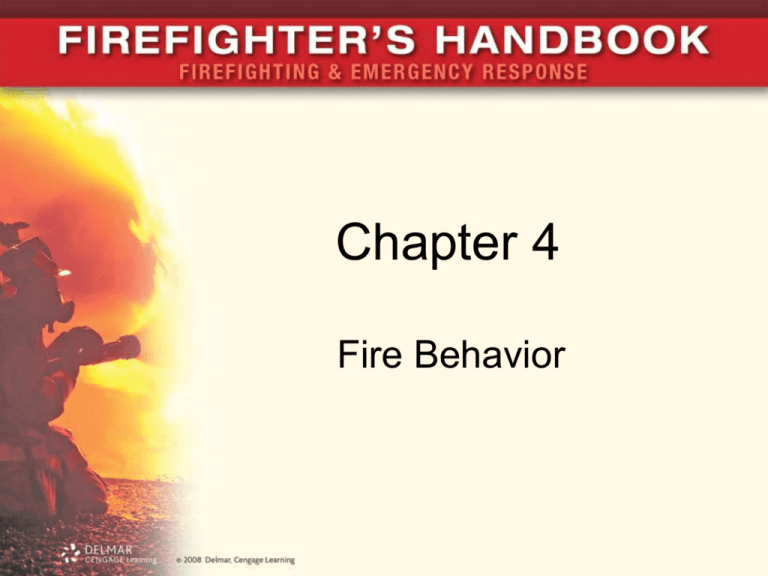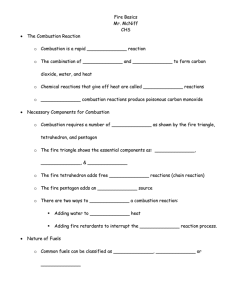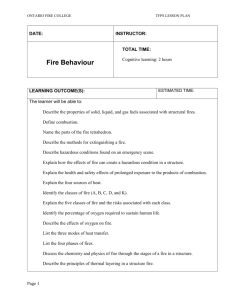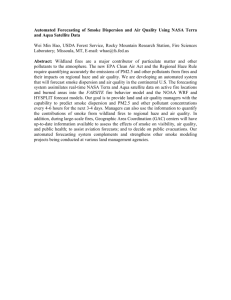Chapter 4 - Delmar
advertisement

Chapter 4 Fire Behavior Introduction • Since ancient times, fires has been one of the most important lifesustaining components • Fire has played a major role as a tool in the development of society • Sometimes an ally, sometimes an enemy • Much has been learned about fire in the last thirty years 4.2 Fire Defined • Fire is burning – Burning is combustion – Combustion is a chemical reaction • Deflagration is combustion at a rate below the speed of sound • Detonation is combustion above the speed of sound • Fire tetrahedron is the assembly of heat, fuel, oxygen, and a selfsustaining chemical reaction 4.3 Figure 4-2 The old and new ways of visualizing the combustion process: the fire triangle and the fire tetrahedron. 4.4 Figure 4-3 An exothermic reaction. 4.5 Heat • For a fire to begin, fuels need to be heated • Chemical heat: various chemicals react with each other • Mechanical heat: friction of two materials rubbing against each other • Electricity most recognized source of heat • Nuclear heat comes from unstable radioactive materials 4.6 Figure 4-5 Heat from friction can be produced whenever any rubbing or compression occurs. 4.7 Figure 4-6 Electricity is simply a flow of electrons from a place where there are many to a place where they are lacking. 4.8 Figure 4-7 The process of creating nuclear energy and heat. 4.9 Fuel • Material consumed by the combustion process • Molecules in a solid are packed closely together • Liquid’s ability to burn depends on substance's ability to place its molecules into suspension • Gaseous fuels are in a state of suspension – Primed for combustion • Fuel must be at a certain temperature before combustion can take place 4.10 Figure 4-8 States of matter. Solid materials have dense arrangements of molecules whereas gaseous molecules are more free-flowing. 4.11 Oxygen • Acts as a catalyst for the combustion process • Oxidation is the process of oxygen bonding to other elements and compounds • Oxidation affects the process of combustion • Chemical reaction accelerated with an abundance of oxygen 4.12 Figure 4-11 The speed of combustion is affected by the amount of oxygen present. 4.13 Chemical Chain Reaction • When heat, fuel, and oxygen combine to start combustion, a chemical chain reaction forms • Scientists discovered certain chemicals introduced into burning process can stop flaming • Foundation for understanding how fires begin is grounded in the fire tetrahedron 4.14 Fire Growth • Once a fire begins, it will grow in a self-sustaining manner • The heat being released will be transferred to other fuels • The firefighter who understands fire growth can better predict fire behavior 4.15 Modes of Heat Transfer • Heat is a by-product of combustion • Conduction is the transfer of heat through a solid object • Convection is the transfer of heat through air and liquid currents • Radiation is the transfer of heat through invisible lightwaves 4.16 Figure 4-12 Examples of heat transfer in fire. 4.17 Figure 4-14 A natural fire plume in an unrestricted space. 4.18 (A) (B) Figure 4-16 (A) Radiation, single heat source. (B) Radiation, multiple heat sources. 4.19 Fire Phases • Burning occurs in clearly defined phases • Ignition phase: substance begins to heat up, liberates gases that can burn • Growth phase: fire begins to grow from the point of ignition • Fully developed phase: all contents within perimeter of fire's boundaries are burning • Decay stage: all fuel consumed and the fire diminishes in size 4.20 Figure 4-17 The four phases of fire. 4.21 Figure 4-19 Full involvement of a structure is an example of a fully-developed-phase fire. 4.22 Products of Combustion • Matter is neither lost nor gained; it changes form • By-products of burning process are heat, light, and smoke • Heat causes dehydration, heat exhaustion, and burns • Light can cause damage to eyesight • Smoke is the most dangerous product of combustion 4.23 Figure 4-21 The products of combustion are deadly and include light, heat, and smoke. 4.24 Specific Fire Characteristics and Events • Liquid, electrical, and metal fires have certain characteristics • Several unique fire events can occur within a compartment or structure • Learning to “read smoke” can help predict fire behavior 4.25 Liquid Fires • Liquid fuels must vaporize • Vaporization is the process in which liquids are converted to gas or vapor • Most liquid fires do not mix well with water – Typically extinguished by coating the liquid with an agent such as foam • Liquid heated to a high pressure in a closed vessel can explode – BLEVE (boiling liquid expanding vapor explosion) 4.26 Figure 4-23 A boiling liquid vapor explosion (BLEVE). 4.27 Electrical Fires • Class C fire: electrical energy is creating heat • Control of a Class C fires begins with control of electricity • Fire control efforts are aimed toward Class A or B materials • Use of water can present extreme shock hazards while fire is still electrically energized 4.28 Metal Fires • Class D metal fire is a chemical reaction fire • In some cases, the presence of water will cause a violent reaction • Control of Class D fires can be quite difficult or amazingly simple • Shape, size, amount, and type of metal burning will dictate the best extinguishment method 4.29 Hostile Fire Events • Any uncontrolled fire in a building is a hostile fire event • Hostile fire event: unique fire phenomenon – Flashover – Backdraft – Rapid fire spread 4.30 Reading Smoke at Structural Fires • Firefighter applies understanding of basic fire behavior by reading smoke – Helps discover clues about the location of the fire • Smoke volume is an indicator of the amount of fuels that are “off-gassing” • Smoke velocity is an indicator of pressure that has built up within the building • Smoke density is indicative of the amount of fuel that is laden within the smoke 4.31 Figure 4-24 Smoke leaving a building has four attributes: volume, velocity, density, and color. (Photo by Keith Muratori from FIREGROUNDIMAGES.com) 4.32 Figure 4-25 Turbulent smoke flow is a warning sign of impending flashover. The brown smoke issuing from the eves indicates that the roof trusses have been heated—a collapse warning sign. (Photo by Keith Muratori from FIREGROUNDIMAGES .com) 4.33 Table 4-3 Reading Smoke Shortcuts 4.34 Lessons Learned • Firefighter survival and fire attack effectiveness is dependent on the understanding of fire dynamics – – – – – – Ingredients needed for combustion Heat sources Fuels Fire phases Special considerations Reading smoke 4.35








